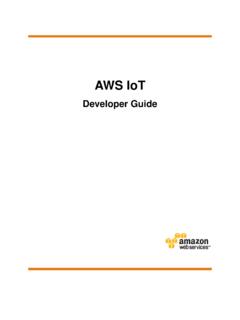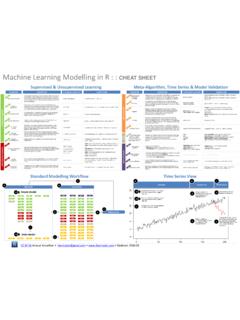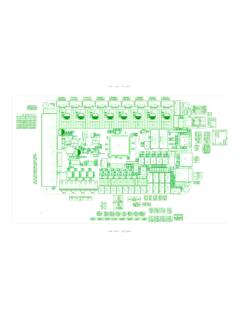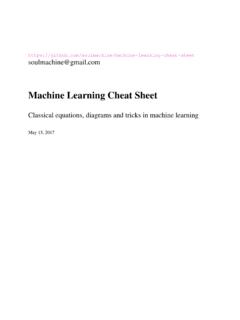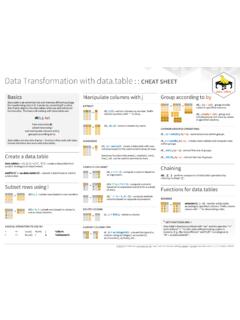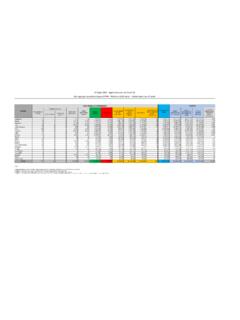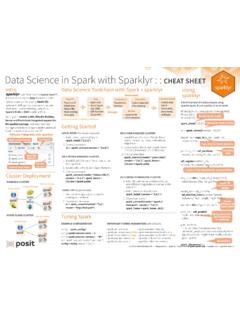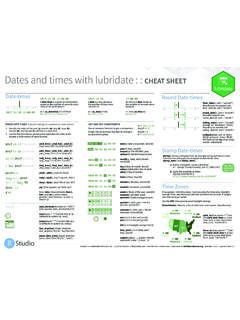Transcription of Dates and times with lubridate : : CHEAT SHEET
1 2018-01-31 11:59:59 UTCJFMAMJASONJDxJFMAMJASONJDx2018-01-31 11:59:592018-01-31 11:59:592018-01-31 11:59:592018-01-31 11:59:592018-01-31 11:59:592018-01-31 11:59:592018-01-31 11:59:592017-11-28 12:00:00 RStudio is a trademark of RStudio, PBC CC BY SA RStudio 844-448-1212 Learn more at lubridate Updated: 2021-07 Dates and times with lubridate : : CHEAT SHEET Date-times2017-11-28 12:00:00 A date-time is a point on the timeline, stored as the number of seconds since 1970-01-01 00:00:00 UTC dt <- as_datetime(1511870400) ## " 2017 -11-28 12:00:00 UTC" the order of the year (y), month (m), day (d), hour (h), minute (m) and second (s) elements in your data.
2 The function below whose name replicates the order. Each accepts a tz argument to set the time zone, ymd(x, tz = "UTC").PARSE DATE- times (Convert strings or numbers to date- times )date_decimal(decimal, tz = "UTC") date_decimal( ) now(tzone = "") Current time in tz (defaults to system tz). now() today(tzone = "") Current date in a tz (defaults to system tz). today() fast_strptime() Faster strptime. fast_strptime('9/1/01', '%y/%m/%d') parse_date_time() Easier strptime. parse_date_time("9/1/01", "ymd")ymd_hms(), ymd_hm(), ymd_h(). ymd_hms(" 2017 -11-28T14:02:00") ydm_hms(), ydm_hm(), ydm_h(). ydm_hms(" 2017 -22-12 10:00:00") mdy_hms(), mdy_hm(), mdy_h().
3 Mdy_hms("11/28/ 2017 1:02:03") dmy_hms(), dmy_hm(), dmy_h(). dmy_hms("1 Jan 2017 23:59:59") ymd(), ydm(). ymd(20170131) mdy(), myd(). mdy("July 4th, 2000") dmy(), dym(). dmy("4th of July '99") yq() Q for quarter. yq("2001: Q3") my(), ym(). my("07-2020") hms::hms() Also lubridate ::hms(), hm() and ms(), which return periods.* hms::hms(sec = 0, min= 1, hours = 2, roll = FALSE) 2017 -11-28T14:02:002017-22-12 10:00:0011/28/ 2017 1:02:031 Jan 2017 23:59:5920170131 July 4th, 20004th of July '992001: Q32 A date is a day stored as the number of days since 1970-01-01 d <- as_date(17498) ## " 2017 -11-28"12:00:00 An hms is a time stored as the number of seconds since 00:00:00 t <- hms::as_hms(85) ## 00:01:25 GET AND SET COMPONENTS date(x) Date component.
4 Date(dt) year(x) Year. year(dt) isoyear(x) The ISO 8601 year. epiyear(x) Epidemiological year. month(x, label, abbr) Month. month(dt) day(x) Day of month. day(dt) wday(x, label, abbr) Day of week. qday(x) Day of quarter. hour(x) Hour. hour(dt) minute(x) Minutes. minute(dt) second(x) Seconds. second(dt) tz(x) Time zone. tz(dt) week(x) Week of the year. week(dt) isoweek() ISO 8601 week. epiweek() Epidemiological week. quarter(x) Quarter. quarter(dt) semester(x, with_year = FALSE) Semester. semester(dt) am(x) Is it in the am? am(dt) pm(x) Is it in the pm? pm(dt) dst(x) Is it daylight savings? dst(d) leap_year(x) Is it a leap year?
5 Leap_year(d) update(object, .., simple = FALSE) update(dt, mday = 2, hour = 1)Use an accessor function to get a component. Assign into an accessor function to change a component in place. d ## " 2017 -11-28" day(d) ## 28 day(d) <- 1 d ## " 2017 -11-01"JanuaryxxxxxxxxTime ZonesR recognizes ~600 time zones. Each encodes the time zone, Daylight Savings Time, and historical calendar variations for an area. R assigns one time zone per vector. Use the UTC time zone to avoid Daylight Savings. OlsonNames() Returns a list of valid time zone names. OlsonNames() () Gets current time zone. with_tz(time, tzone = "") Get the same date-time in a new time zone (a new clock time).
6 Also local_time(dt, tz, units). with_tz(dt, "US/Pacific") force_tz(time, tzone = "") Get the same clock time in a new time zone (a new date-time). Also force_tzs(). force_tz(dt, "US/Pacific")PTMTCTET7:00 Eastern6:00 Central5:00 Mountain4:00 Pacific7:00 Eastern7:00 Central7:00 Mountain7:00 Pacificstamp() Derive a template from an example string and return a new function that will apply the template to date- times . Also stamp_date() and stamp_time(). a template, create a function sf <- stamp("Created Sunday, Jan 17, 1999 3:34") the template to Dates sf(ymd("2010-04-05")) ## [1] "Created Monday, Apr 05, 2010 00:00" Tip: use a date with day > 12 Stamp Date-timesRound Date-timesfloor_date(x, unit = "second") Round down to nearest unit.
7 Floor_date(dt, unit = "month") round_date(x, unit = "second") Round to nearest unit. round_date(dt, unit = "month") ceiling_date(x, unit = "second", change_on_boundary = NULL) Round up to nearest unit. ceiling_date(dt, unit = "month")JanFebMarAprJanFebMarAprJanFebMa rAprValid units are second, minute, hour, day, week, month, bimonth, quarter, season, halfyear and year. rollback( Dates , roll_to_first = FALSE, preserve_hms = TRUE) Roll back to last day of previous month. Also rollforward(). rollback(dt)07-2020 Make an interval with interval() or %--%, i <- interval(ymd(" 2017 -01-01"), d) ## 2017 -01-01 UTC-- 2017 -11-28 UTC j <- d %--% ymd(" 2017 -12-31") ## 2017 -11-28 UTC-- 2017 -12-31 UTCPERIODSDURATIONSRS tudio is a trademark of RStudio, PBC CC BY SA RStudio 844-448-1212 Learn more at lubridate Updated.
8 2021-07 Add or subtract periods to model events that happen at specific clock times , like the NYSE opening a period with the name of a time unit pluralized, p <- months(3) + days(12) p "3m 12d 0H 0M 0S"Make a duration with the name of a period prefixed with a d, dd <- ddays(14) dd "1209600s (~2 weeks)"Add or subtract durations to model physical processes, like battery life. Durations are stored as seconds, the only time unit with a consistent length. Difftimes are a class of durations found in base of of monthsExact length in secondsEquivalent in common unitsINTERVALSD ivide an interval by a duration to determine its physical length, divide an interval by a period to determine its implied length in clock with Date- times lubridate provides three classes of timespans to facilitate math with Dates and date- times .
9 A %within% b Does interval or date-time a fall within interval b? now() %within% i int_start(int) Access/set the start date-time of an interval. Also int_end(). int_start(i) <- now(); int_start(i) int_aligns(int1, int2) Do two intervals share a boundary? Also int_overlaps(). int_aligns(i, j) int_diff( times ) Make the intervals that occur between the date- times in a vector. v <-c(dt, dt + 100, dt + 1000); int_diff(v) int_flip(int) Reverse the direction of an interval. Also int_standardize(). int_flip(i) int_length(int) Length in seconds. int_length(i) int_shift(int, by) Shifts an interval up or down the timeline by a timespan.
10 Int_shift(i, days(-1)) (x, start, ..) Coerce a timespan to an interval with the start date-time. Also (). (days(1), start = now()) l Start DateEnd DateMath with date- times relies on the timeline, which behaves inconsistently. Consider how the timeline behaves during: A normal day nor <- ymd_hms("2018-01-01 01:30:00",tz="US/Eastern") The start of daylight savings (spring forward) gap <- ymd_hms("2018-03-11 01:30:00",tz="US/Eastern") The end of daylight savings (fall back) lap <- ymd_hms("2018-11-04 00:30:00",tz="US/Eastern") Leap years and leap seconds leap <- ymd("2019-03-01")12:001:002:003:00201920 2020211:002:003:004:001:002:003:004:00 Durations track the passage of physical time, which deviates from clock time when irregularities occur.

